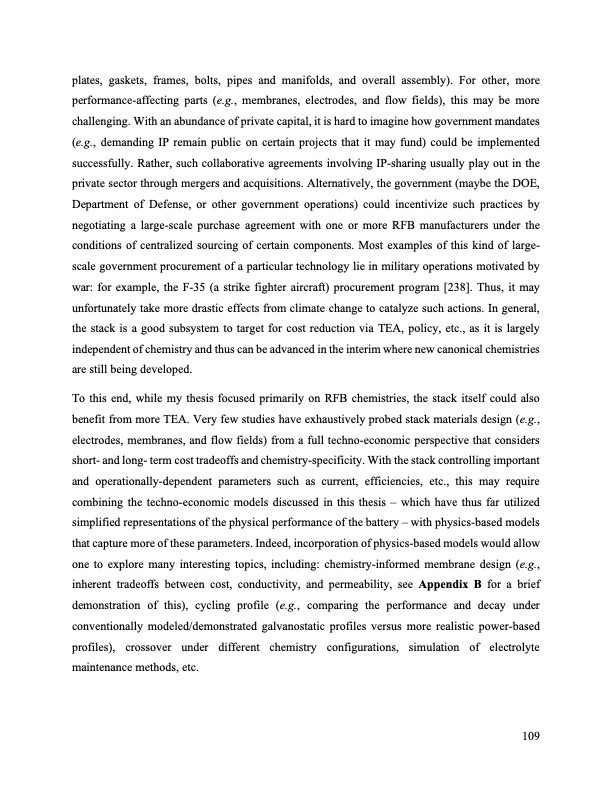
PDF Publication Title:
Text from PDF Page: 109
plates, gaskets, frames, bolts, pipes and manifolds, and overall assembly). For other, more performance-affecting parts (e.g., membranes, electrodes, and flow fields), this may be more challenging. With an abundance of private capital, it is hard to imagine how government mandates (e.g., demanding IP remain public on certain projects that it may fund) could be implemented successfully. Rather, such collaborative agreements involving IP-sharing usually play out in the private sector through mergers and acquisitions. Alternatively, the government (maybe the DOE, Department of Defense, or other government operations) could incentivize such practices by negotiating a large-scale purchase agreement with one or more RFB manufacturers under the conditions of centralized sourcing of certain components. Most examples of this kind of large- scale government procurement of a particular technology lie in military operations motivated by war: for example, the F-35 (a strike fighter aircraft) procurement program [238]. Thus, it may unfortunately take more drastic effects from climate change to catalyze such actions. In general, the stack is a good subsystem to target for cost reduction via TEA, policy, etc., as it is largely independent of chemistry and thus can be advanced in the interim where new canonical chemistries are still being developed. To this end, while my thesis focused primarily on RFB chemistries, the stack itself could also benefit from more TEA. Very few studies have exhaustively probed stack materials design (e.g., electrodes, membranes, and flow fields) from a full techno-economic perspective that considers short- and long- term cost tradeoffs and chemistry-specificity. With the stack controlling important and operationally-dependent parameters such as current, efficiencies, etc., this may require combining the techno-economic models discussed in this thesis – which have thus far utilized simplified representations of the physical performance of the battery – with physics-based models that capture more of these parameters. Indeed, incorporation of physics-based models would allow one to explore many interesting topics, including: chemistry-informed membrane design (e.g., inherent tradeoffs between cost, conductivity, and permeability, see Appendix B for a brief demonstration of this), cycling profile (e.g., comparing the performance and decay under conventionally modeled/demonstrated galvanostatic profiles versus more realistic power-based profiles), crossover under different chemistry configurations, simulation of electrolyte maintenance methods, etc. 109PDF Image | Bringing Redox Flow Batteries to the Grid

PDF Search Title:
Bringing Redox Flow Batteries to the GridOriginal File Name Searched:
Rodby-krodby-phd-chemE-2022-thesis.pdfDIY PDF Search: Google It | Yahoo | Bing
Salgenx Redox Flow Battery Technology: Salt water flow battery technology with low cost and great energy density that can be used for power storage and thermal storage. Let us de-risk your production using our license. Our aqueous flow battery is less cost than Tesla Megapack and available faster. Redox flow battery. No membrane needed like with Vanadium, or Bromine. Salgenx flow battery
| CONTACT TEL: 608-238-6001 Email: greg@salgenx.com | RSS | AMP |